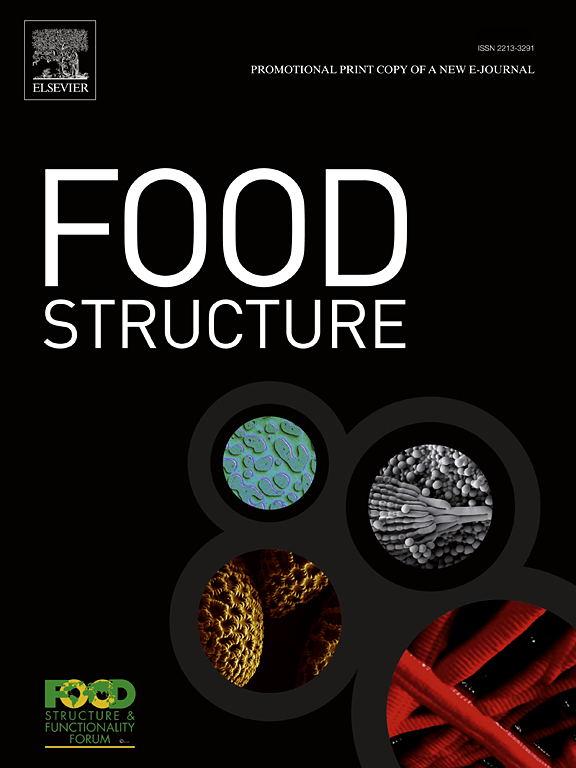Enhanced bioactive and rheological properties of 3D xanthan gum matrices using grape by-product-based particles obtained by spray drying
IF 5.9
3区 农林科学
Q1 FOOD SCIENCE & TECHNOLOGY
引用次数: 0
Abstract
The development of innovative 3D printing matrices enriched with bioactive compounds seamlessly integrates sustainable practices with cutting-edge advancements in functional material design. In this sense, the main objectives of this study were to produce particles enriched with grape pomace extract through spray drying and to evaluate their effect on the active and rheological properties of matrices based on xanthan gum for 3D printing. The extract, obtained by pressurized liquid extraction (PLE), was characterized regarding total phenolic compounds (TPC), anthocyanin content (TA), and antioxidant activity (AA): 3.58 ± 0.02 μg GAE/mL of extract, 219.3 ± 32.2 μg AT/mL of extract and 6.4 ± 0.5 nmol FeSO4/mL of extract, respectively. The extract was mixed with maltodextrin (10 % w/v) and spray dried, resulting in spherical microparticles containing: 3.5 ± 0.5 mg GAE/g, 514.1 ± 28.5 μg TA/g and 86.5 ± 4.5 μmol FeSO4/g. The microparticles were applied in two formulations of gels for 3D printing using xanthan gum and sodium alginate. The samples demonstrated an increased consistency index, storage modulus (G’) value, and resistance to deformation with the addition of particles. The printed particle samples exhibited behavior in accordance with the rheological analysis, showing increased viscoelasticity in comparison to the control, since they demonstrated improved concordance with the computer-aided design (CAD) software models. This suggests that the phenolic compounds from grape pomace extracts interact with xanthan gum, creating matrices suitable for 3D printing with active properties. These matrices have potential applications in various fields, such as anthocyanin-based pH indicators, nutraceuticals, and functional foods.
利用喷雾干燥获得的葡萄副产品为基础的颗粒增强三维黄原胶基质的生物活性和流变性能
富含生物活性化合物的创新3D打印矩阵的开发无缝地将可持续实践与功能材料设计的前沿进步相结合。因此,本研究的主要目的是通过喷雾干燥生产富含葡萄渣提取物的颗粒,并评估其对3D打印黄原胶基质活性和流变性能的影响。采用压力液体萃取法(PLE)对其总酚类化合物(TPC)、花青素含量(TA)和抗氧化活性(AA)进行表征,分别为3.58 ± 0.02 μg GAE/mL、219.3 ± 32.2 μg AT/mL和6.4 ± 0.5 nmol FeSO4/mL。将提取液与麦芽糖糊精(10 % w/v)混合后喷雾干燥,得到球形微颗粒,含:3.5 ± 0.5 mg GAE/g、514.1 ± 28.5 μg TA/g和86.5 ± 4.5 μmol FeSO4/g。将微颗粒应用于黄原胶和海藻酸钠的两种3D打印凝胶配方中。随着颗粒的加入,样品的一致性指数、存储模量(G’)值和抗变形能力都有所提高。打印的颗粒样品表现出与流变分析一致的行为,与对照相比,表现出更高的粘弹性,因为它们与计算机辅助设计(CAD)软件模型的一致性得到了改善。这表明,葡萄渣提取物中的酚类化合物与黄原胶相互作用,创造出具有活性特性的适合3D打印的基质。这些基质在以花青素为基础的pH指标、营养食品和功能食品等领域具有潜在的应用前景。
本文章由计算机程序翻译,如有差异,请以英文原文为准。
求助全文
约1分钟内获得全文
求助全文
来源期刊

Food Structure-Netherlands
Chemical Engineering-Bioengineering
CiteScore
7.20
自引率
0.00%
发文量
48
期刊介绍:
Food Structure is the premier international forum devoted to the publication of high-quality original research on food structure. The focus of this journal is on food structure in the context of its relationship with molecular composition, processing and macroscopic properties (e.g., shelf stability, sensory properties, etc.). Manuscripts that only report qualitative findings and micrographs and that lack sound hypothesis-driven, quantitative structure-function research are not accepted. Significance of the research findings for the food science community and/or industry must also be highlighted.
 求助内容:
求助内容: 应助结果提醒方式:
应助结果提醒方式:


